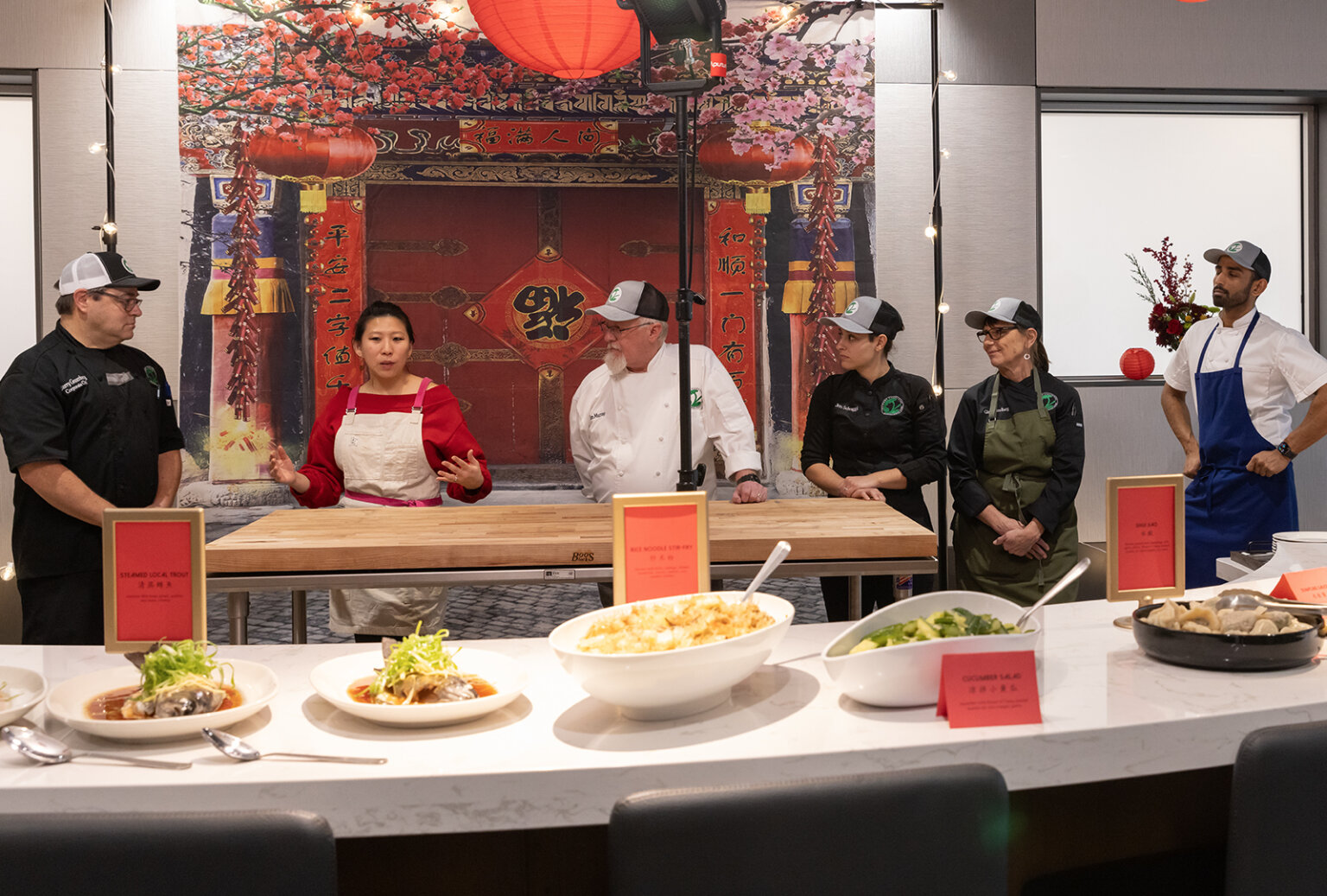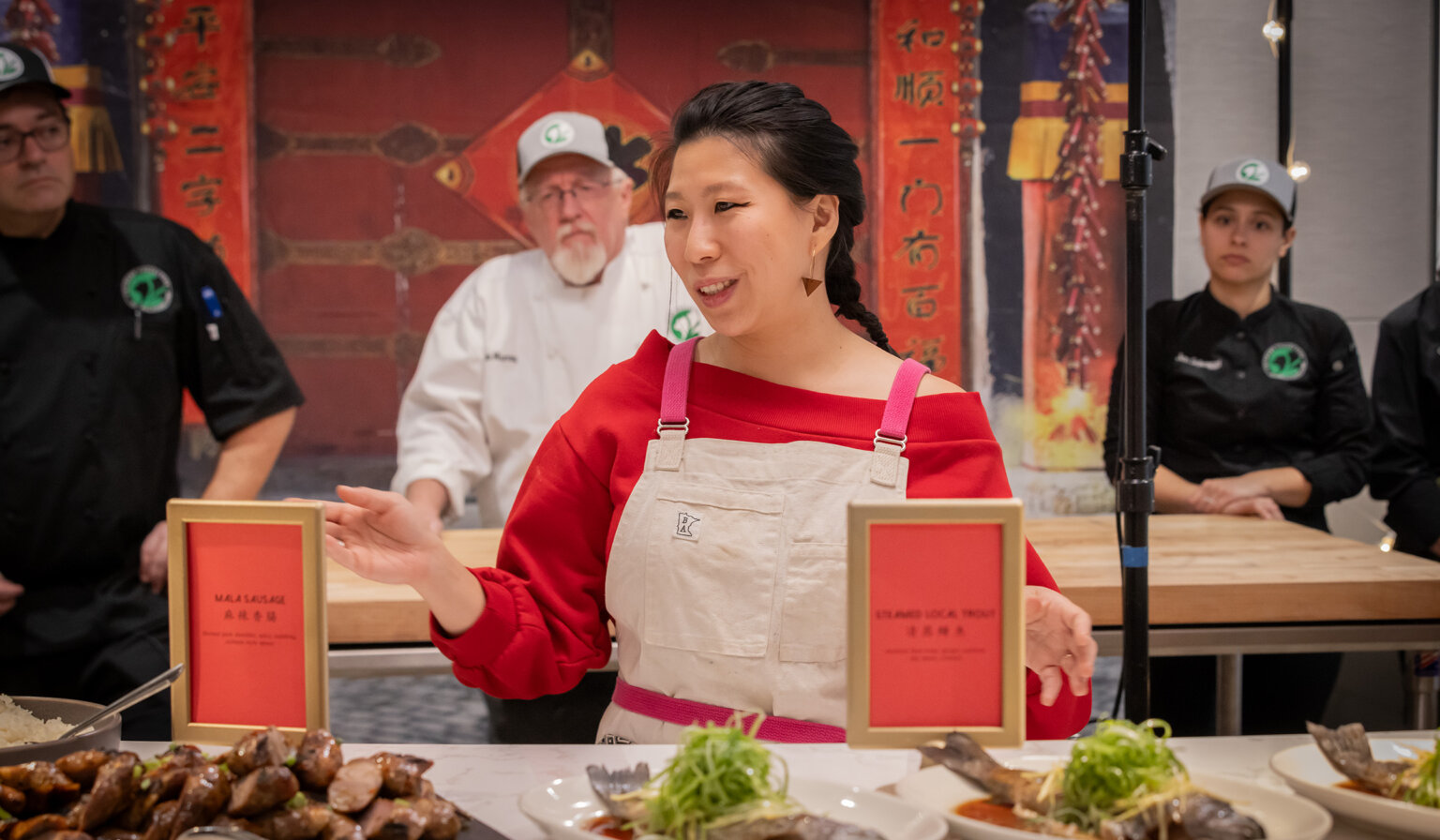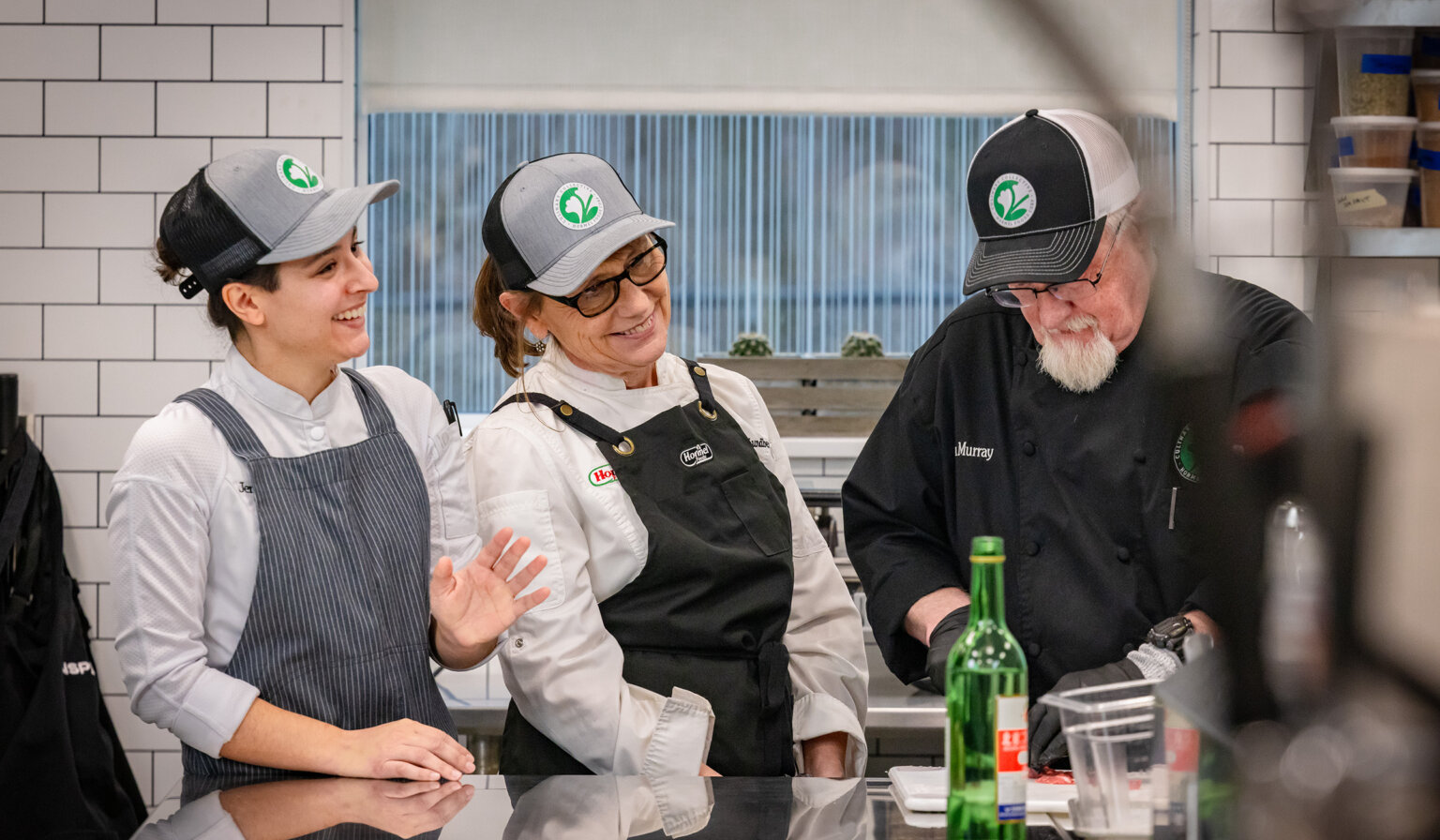January 1 marks a new year and is a day on which people resolve to be better than we were the year before. But January 1 isn’t New Year’s Day around the globe. Many cultures have traditionally based their calendars on the moon cycle. The dates and customs of this day differ across cultures, but in the U.S., Lunar New Year is synonymous with Chinese New Year, which falls on the second new moon after the winter solstice. On the Gregorian calendar, which we use in the U.S., this is a different day each year, generally between mid-January and mid-February.
A key aspect of Lunar New Year that has remained the same over millennia is the importance of food, if not the exact ingredients. Naturally, this concept of traditional food excited the innovation team at Hormel Foods, so the company invited Tiffany Alexandria, chef, visual storyteller and owner of Taiwanese food and culture consultancy CHOOCHOO-ca-CHEW, to cook and speak about Lunar New Year and her family’s culinary traditions. Over three days, Chef Tiffany led some of the chefs of the Hormel Foods Culinary Collective, including chefs Barry Greenberg, Seby Joseph, Jim Murray, Jen Selvaggi and Gina Lundberg in preparing and enjoying a 13-course holiday feast.

Chef Tiffany hails from Taiwan and now lives in Rochester, Minnesota, so she was excited to share her food memories with the group. She recalled the loud noises, bright red color and, most of all, the culinary abundance. “Food is something that brings everybody together. Everybody has to eat. We all eat. That’s the one thing we all have in common. During family holidays we all eat and enjoy a feast, and then the memories get stored in the food.”
Our Menu
This rice cake is called “NiánGāo”(年糕) in Chinese, which literally translates into “Year Cake”. It is essential during Chinese new year because cake in Chinese-“Gāo”(糕), sounds like high “Gāo”(高) in Mandarin. Nian Gao- higher and better every year!
Fish is essential to the Lunar New Year as it symbolizes abundance. Fish in Mandarin is “Yú”(魚), which sounds the same as “Yú”(餘), extra. “NiánNiánYǒuYú” (年年有餘) is a greeting phrase used during the lunar new year, wishing everyone having abundance year after year. It is also important that the fish is served with the head and the tail, it symbolizes having a start and an end. Fish is also never finished on the Lunar New Year eve dinner to further emphasize having extra to carry over into the new year.
Most dishes on the new year dinner table can be a little heavier, lighter dishes are important to help balance out the meal.
Rice noodle stir-fry isn’t the most common dish on the lunar new year dinner table. However, every year during the lunar new year, family and friends would visit each other and have little get-togethers like people do during Christmas in America, and one of my parents’ friends would always make her specialty rice noodle stir-fry during the get-together. The sound of aunties and uncles chattering, mahjong clacking and “GōngXǐ GōngXǐ” greetings, red envelopes being stuffed into my pockets while my parents tell me not to take them from aunties and the taste of rice noodle stir-fry has become part of my vivid lunar new year memories.
“JiǎoZi” , or dumplings as most westerners know them, is something we always eat during the lunar new year. The shape of these dumplings looks like the ancient Chinese gold nuggets so they symbolize wealth and prosperity. My family would gather before the lunar new year dinner and fold dumplings together and catch up on each other’s lives or tell stories from the past. We would hide a coin in one of the dumplings and whoever gets the coin while eating the dumplings will have even more good luck in the following year. Garlic chives are eaten during the lunar new year because “Jiǔ”Cài(韭菜) sounds like longevity “Jiǔ”(久) in mandarin, we eat it to live a longer life.
The dish is named after the famous Chinese Song dynasty writer, poet, painter, calligrapher, pharmacologist, gastronome, and statesman named Su Dongpo. Above all the talents that are mentioned, it’s also said that Su Dongpo is a great cook and braised pork belly is his specialty. When he was in Hangzhou, he helped solve the flooding during that time. The villagers knew that Su Dongpo enjoyed braised pork so they gifted him with pork during Chinese new year. Su Dongpo asked his family to cut the pork into cubes and braised them with yellow rice wine(ShaoXing) and soy sauce then gifted the dish back to the villagers, everyone enjoyed them so much and they named the dish Dongpo Pork.
Lion’s head are giant meatballs, the round shape symbolizes reunion “TuánTuánYuánYuán”(團團圓圓), and the golden color brings prosperity and wealth to the table. Each meatball also symbolizes luck, good fortune, longevity, and happiness.
Radish cake is something my grandma would make every lunar new year, since radish “tshài-thâu” (菜頭) in Taiwanese sounds similar to good luck “CǎiTóu” (彩頭), and cake “Gāo” (糕) sounds the same as high “Gāo” (高), eating this dish will bring lots of luck to the new year. The cake is steamed then cut into squares and pan fried until golden and crispy on the outside, making the radish cake look like golden bricks, and that’s what we call them sometimes for extra wealth and prosperity.
There are always some types of sausage on the lunar new year dinner table. Back in the day, people didn’t eat meat as often but during the holidays hogs would be slaughtered and making sausages is a way to preserve the pork for the coming year. Another reason for having sausages on the dinner table is because sausages are called “XiāngCháng” (香腸) which sounds like longevity “ChángChángJiǔJiú”(長長久久). Mala sausage isn’t something that’s on most Taiwanese’s dinner tables, but my paternal grandfather was originally from Sichuan so the flavor became something he craves and this type of sausage can only be found once a year before the lunar new year in the little market by the military village he lived in.
Fa Gao’s literal translation is the cake that expands, but “fa” also means prosperity. These little muffin-looking cakes are steamed on high heat to achieve the split-top look. The bigger the crack on top is, the more prosperous the next year is going to be.
Rice is a staple food for most families in Asia, rice is not only food, it is also synonymous with wealth. Making sure there’s enough uncooked rice in the rice container not only symbolizes the family won’t go hungry next year but also will be full (滿) of wealth.
During the lunar new year, families would visit temples and pray for good health and fortune, temples often offer small bags of rice wrapped in a red envelope as blessed rice for people to take home and eat for good luck and health.
Sauces are great ways for guests to make the dishes on the table their own. There would always be multiple sauces on the dinner table as my grandfather enjoys food much saltier than the rest of us. Most sauces are soy sauce based, mixed with vinegar and often garlic for dipping dumplings or radish cake. Garlic in Mandarin is called “Suàn”(蒜), which sounds like counting “Suàn”(算), by eating garlic people are blessed to have countless money to count in the new year.
After dinner desserts are most often fruits in Asian countries, and during lunar new year we eat fruit for good fortune. Pineapple in Taiwanese is called “ông-lâi”(旺來), it symbolizes flourishing prosperity and good luck “HǎoYùnWàngWàngLái”(好運旺旺來); apple “PíngGuǒ”(蘋果) symbolizes safety “PíngPíngĀnĀn”(平平安安); oranges or tangerines “Jú”(橘/桔) symbolizes big fortune and great profit “DàJíDàLì”(大吉大利).
A different legend explains the twelve animals of the Chinese zodiac that are celebrated in turn each Lunar New Year. There are many variations, but in the most common story, the mythical Jade Emperor held a race across the river to decide which twelve animals would be represented. The strong and kind Ox carried the Rat and Cat on his back, but just before reaching shore, the Rat pushed the Cat into the river and hopped off, coming in first place, followed by the Ox. Next were the Tiger, Rabbit and Dragon, followed by the Snake, Horse, Goat, Monkey, Rooster, Dog and Pig.

Over time, Lunar New Year legends and customs evolved. Today, China calls Lunar New Year the “Spring Festival,” the heralding of new life, and it’s the most important holiday for the country. There is no longer a beast to be appeased; instead, it’s an opportunity for families and communities to gather together and enjoy dishes that symbolize their hopes for the new year. This year is a particularly lucky one: 2024 is the Year of the Dragon.
Some variations of the celebration are honored in many countries with significant Chinese populations, including Vietnam, South Korea, Singapore and Malaysia. In some countries, the holiday is still formally called “Chinese New Year” because of its origin, though each country has its own twist as cultures blended and local ingredients were incorporated into the New Year feast. Lunar New Year has evolved further in the melting pot that is the U.S., melding the culinary traditions of immigrants from all around the world.
Chef Tiffany taught her fellow chefs how to prepare a full Lunar New Year feast — 13 symbolic dishes that were unique to her own experience. In addition to making sausages, they folded hundreds of dumplings, just as her family used to do together. As Italian American Chef Barry pinched the soft dough of his dumpling wrapper, he recounted similarly rolling out pasta dough as a child with his family to make lasagna from scratch.

“I love little moments like this,” Chef Tiffany exclaimed, remarking on the similarity. “It’s not just about me sharing my culture with you. It’s also about you sharing your culture with me.”
Later, reflecting on their dumpling-making session, Chef Seby described more lessons from Chef Tiffany, including a new “eye-opening” method of rolling dough and lots of new-to-him ingredients that he now feels empowered to use and maybe even experiment with. “Knowledge is power,” he said. From a culinary perspective, the chefs’ cultural exchange was representative of the evolution of the holiday itself, as Lunar New Year spread to new places and incorporated the local foods and customs of its adopted lands.
“Here in America, we have a melting pot of different cultures,” Chef Jen Selvaggi said, echoing Chef Tiffany. “So it’s nice to understand through a different lens, from a different perspective. No matter where you’re from, we all eat, we all share those memories, so food is something that brings people together in a way that is universal.”

Ingredients
| Lion’s Head (meatball) | |
|---|---|
| Oil for Deep Frying | |
| 1 | pound JENNIE-O® Ground Turkey |
| ½ | box firm tofu, crumbled |
| ½ | sweet onion, finely diced |
| 2 | tablespoons cornstarch |
| 1½ | tablespoons HOUSE OF TSANG® Toasted Sesame Oil |
| 1 | tablespoon HOUSE OF TSANG® Classic Stir-Fry Sauce |
| 1 | Shaoxing wine |
| 1 | egg white |
| 1 | tablespoon salt |
| ½ | tablespoon sugar |
| 1 | teaspoon grated ginger |
| 1 | teaspoon white pepper |
| Broth Base | |
|---|---|
| 1 | small head napa cabbage, cut into 2” sections |
| 1 | cup water |
| 1 | carrot, cut into ⅛” thick coins |
| 1 | teaspoon salt |
Directions
For the Lion’s Head (meatball)
In large bowl, combine Lion’s Head ingredients. Mix vigorously until very sticky. Portion the mixture into 6 meatballs, each about the size of a baseball.
In large saucepan, heat oil for deep frying. Fry meatballs until golden brown on the outside. They will not be completely cooked through.
For the Broth Base
In another large saucepan, place cabbage, water, carrot and salt. Place meatballs on top. Bring to boil, reduce heat to medium. Cover. Cook 15 minutes or until cabbage is softened and meatballs are cooked through. Season with additional salt or soy sauce to taste.





























